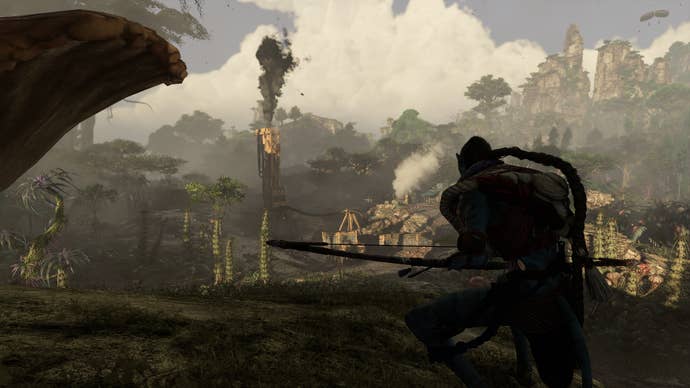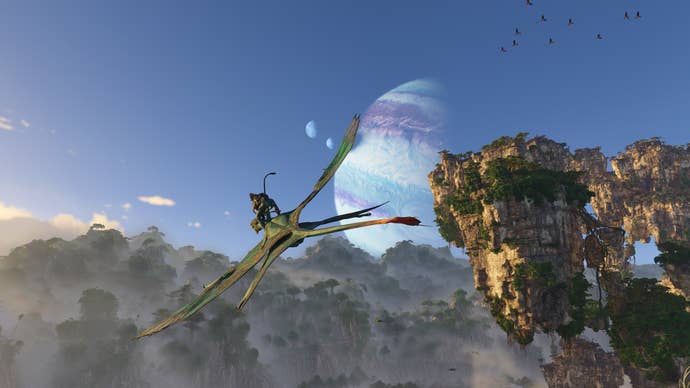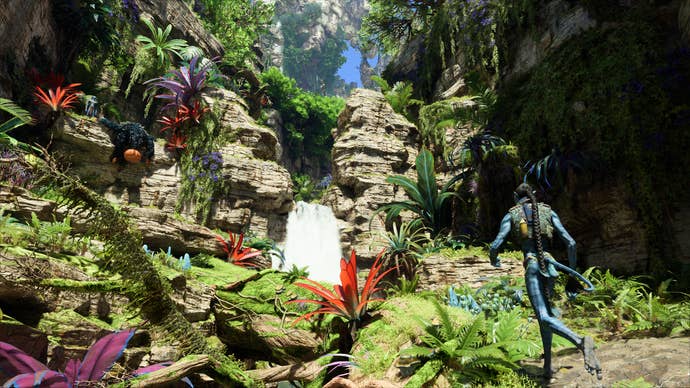Avatar: Frontiers of Pandora review – A lovely new world to Na’vigate
The Ubisoft heritage is strong, but not overwhelming, in one of the most carefully crafted big IP games in recent memory.
Modern triple-A open-world games rarely make your jaw drop by using only vibes and putting aside all the fireworks. But Avatar: Frontiers of Pandora manages to do exactly that, every few minutes. It’s a familiar journey that lacks sharp edges, sure, but it’s also a game that knows what it wants to be and trusts the source material.
No matter how you feel about James Cameron’s on-going saga of tree-hugging sci-fi adventures, it’s hard to deny there’s a huge audience out there that want to experience their own treks through Pandora’s jungles. The first Avatar movie received a forgettable tie-in game all the way back in 2009 (also handled by Ubisoft), so the bar was kind of low for the next attempt at capturing the magic of Pandora and recreating a Na’vi power fantasy. However, the powers that be chose to go all in when they next approached the idea of a big-budget Avatar game.
Massive Entertainment initially felt like an odd pick to develop a gargantuan Avatar game. After all, Assassin’s Creed and Far Cry have become Ubisoft’s go-to blueprints for open-world titles, with Massive instead had specializing in co-op looter shooters. But this deviation from its norm was the first step in the right direction for Frontiers of Pandora; it may look the part, and often feel like a sci-fi riff on Far Cry Primal, but ultimately it has a voice of its own and rewards exploring and connecting with the world over grinding RDA bases for sick loot.

Mind you, the “numbers go up” itemization and the usual skill point-based progression systems exist in Frontiers of Pandora, but Massive clearly used this opportunity to step out of their comfort zone and try something new. For starters, the game is strictly played in first-person for maximum immersion except when you’re riding your trusty ikran or a fast direhorse across Pandora’s Western Frontier. Secondly, it’s a thoughtful exploration of not only the world’s surface-level elements and aesthetics, but also the movies’ core themes and more spiritual aspects.
You’d be hard pressed to believe this was developed by the studio behind Tom Clancy’s The Division. Even on a political level, it’s a 180-degree turn, putting you at the center of the fight against modern imperialism and military “oorah” types. For world-building and story reasons, your (customizable) Na’vi character has access to human weaponry, but using them feels icky. On the other hand, the Na’vi battle and hunting tools feel just right and better suited to the agile movement of the primitive alien species and the many platforming possibilities that Pandora offers.
Avatar: Frontiers of Pandora also managed to disconcert me with the lack of tower-like structures to reveal hectares of the huge and layered map, which is divided in three big regions, each with its own ecosystems (though some local fauna are found everywhere). Instead, the game actively encourages real exploration and using your Na’vi senses to find your way around. While controlling a 9-feet tall blue alien might not sound too dissimilar from playing as a human, there’s a uniqueness to how you move through natural environments which are giant for humans and high-tech corridors that are too small for Na’vi.

This plays into the Na’vi power fantasy at the center, which is supported by the skill trees you’d expect to find in modern open-world games with light RPG elements, and unique abilities are acquired by connecting to Eywa at certain locations. It’d have been really easy to simply embrace the 'action movie' side of Avatar, but searching for trinkets and meaningful landmarks (as well as many of the side quests) often yield rewards that are more important than better items and weapons: the information and deep lore that James Cameron and his teams didn’t manage to cram into the Avatar movies.
At this point, it should be obvious: this game was made with Avatar fans (and everyone who loves spending time on Pandora) in mind. All the fun outpost-clearing and shooting in the game doesn’t change the fact its main goal is to allow players to become one with the Na’vi and learn more about their ways and the natural systems they use to thrive and fight against the industrialized invaders.
On basic level, the gameplay loop is recognizable, but the pacing of it isn’t. It’s a game that invites players to absorb the gorgeous vistas and little details over shooting through the many enemy bases which pollute the moon. You’ll be sneaking and shooting your way through plenty of bases, though, so don’t worry if you’re still looking to cause some mayhem.
Even when I was actively looking for crafting and cooking materials, the game liked to remind me Na’vi aren’t disrespectful hunter-gatherers. Quick and clean kills allow you to loot better materials, and the same goes for collecting fruits and plants under the right conditions. This goes directly against the old “do tons of stuff very fast” philosophy that triple-A game design likes to apply to vast swathes of content. Avatar: Frontiers of Pandora might often move like some of its close relatives, but it leverages the most distinctive aspects of the material it’s adapting to behave in more eccentric ways.

Beyond the obvious “rise against the invaders” motif which permeates the whole Avatar franchise, the story goes into some unexpected places as the plot progresses. The early beats are more about the Oblivion-like magic of exploring a new world full of wonder and possibilities (but tainted by humans), while the second half gets progressively more intense and emotional. Things are played relatively safe and close to James Cameron’s blockbusters, but much like in those, the devastating moments don’t fall flat – and the intimate exchanges are poignant and sincere.
As Na’vi who were forcefully enrolled into The Ambassador Program (TAP) by the RDA and the scientists working with them, the main characters and their closest friends are children of two worlds, and that plays into both the story and the playable systems. While I did struggle with the many Na’vi names that were thrown at me over the course of the 20-hour main storyline, most characters are well-defined (visually and on a script level) enough to leave an impression and be recognizable later on. This is all part of the movie canon, by the way, but don’t expect big-name cameos – the story stands on its own and only uses certain events from the movies to give newcomers some context.
The game's inherent charm continues into the main missions. While the objectives and overall design aren’t anything special (much like the limited roster of RDA enemies that are largely variations of the versatile AMP suits), the developers understand how to pace smaller chunks of story and spice things up to avoid monotonous nadirs. Even if you choose to “clean” the map and spend hours doing side quests and tasks, Pandora and its inhabitants are different enough to keep things fresh as long as you don’t marathon the game. Online co-op (crossplay included) for two players only ups the appeal.

Standout moments that will stick with me include leaving the TAP installations for the first time and climbing and walking all the way up to the floating mountains to find my ikran partner. And then, later in the game, during the moments that the game is firing on all cylinders, Avatar: Frontiers of Pandora is enchanting. Massive’s new iteration of the Snowdrop engine is nothing short of impressive, mainly because of the sheer amount of geometry and effects it can pump onto your screen at once without making the whole show go kaput. The cherry on top is that the audio work is every bit as remarkable, with distant and nearby SFX all seamlessly blending together and making Pandora feel truly alive (and the shootouts more dangerous).
Performance is equally impressive besides some oddities (which will likely be patched out) related to AMD FSR3’s frame generation, which honestly feels like as much of a game changer as Nvidia’s take on the same kind of tech. Frontiers of Pandora puts some serious pressure on the GPU, and the frame generation option is a lifesaver here that feels almost obligatory to properly enjoy the game using the High/Ultra settings at 1440p and beyond (on PC, of course).
On the not-so-good side of things, the game becomes a bit messy when the action gets too chaotic in tight spaces. Na’vi aren’t built for prolonged combat encounters, and the experience in some of the more linear sections can be rough unless you cheese certain scenarios (the limited, canon-friendly arsenal doesn’t help either). Likewise, the full potential of aerial combat with the ikran takes a while to blossom, so invest in its skill tree early. And no, tiered equipment certainly wasn’t needed here, though it’s less obstructive than in other modern action-adventure games.

Like it or not, Avatar: Frontiers of Pandora feels like the perfect companion piece to James Cameron’s movies: it’s big but often intimate. Savage but calm. Familiar but charming. Even without playing a single minute of it, you should know whether it’s something you want to play. If you decide to make the jump, I suggest letting go of cheap analogies and using Na’vi instincts first and gamer brain second.
Avatar: Frontiers of Pandora releases on December 7 for PC (version tested), PS5, Xbox Series X/S, and Amazon Luna.
This review was written thanks to code provided by Ubisoft.



